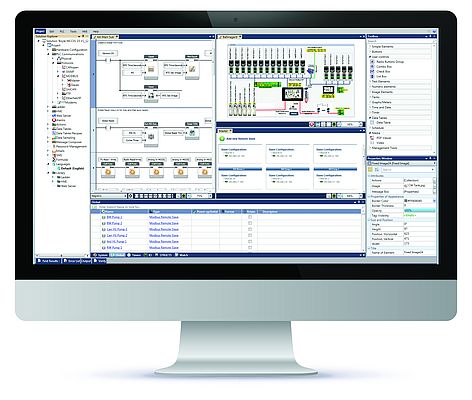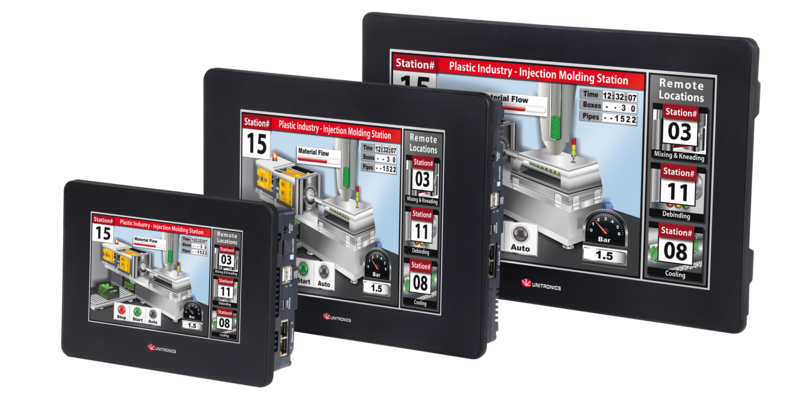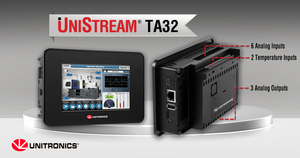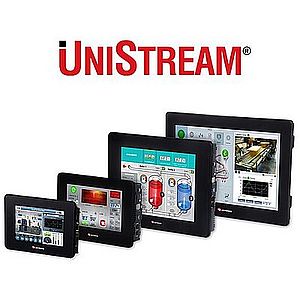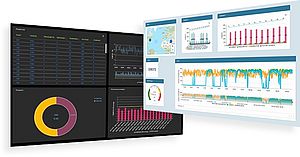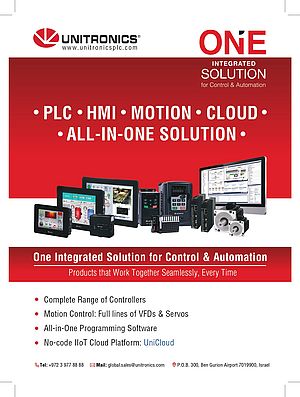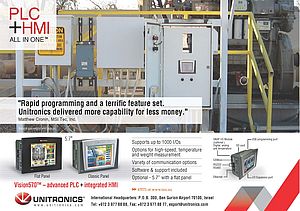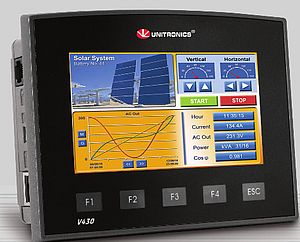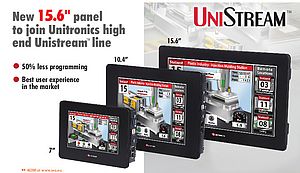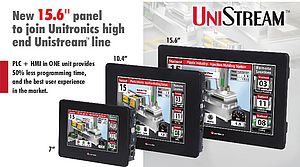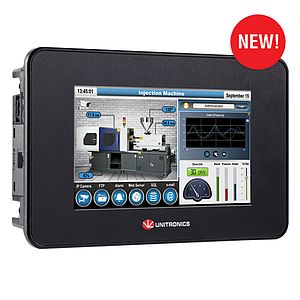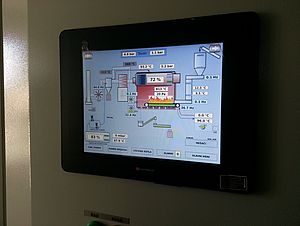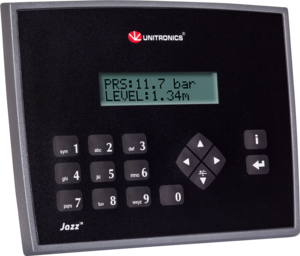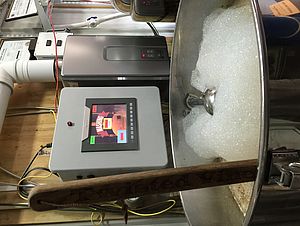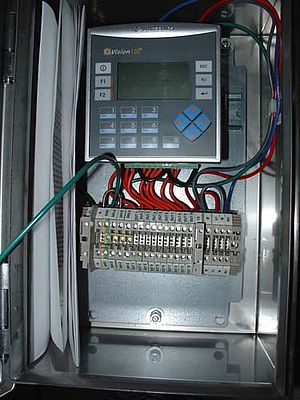UniLogic™ software is the intuitive all-in-one programming environment for Unitronics’ award-winning UniStream™ line, compact PLC + HMI controllers with variety of communication and I/O features.
All-in-One Programming Tool
With Unilogic™, all program components are logically organized in the Solution Explorer: Hardware Configuration, Ladder functions, HMI and Webserver screens, Actions, Data Tables, Data Sampling, as well as all aspects of communications from configuration to SMS and emails. Context-sensitive toolboxes change as you work, offering only the relevant options and functions. Structs are groups of data tags of different types organized into a single, logical unit. UniLogic automatically creates Structs during the programming process to support hardware configuration, and to support complex functions such as Communications and PID control. It is easy to boost programming power by creating specific structs to service program functions and reuse them throughout the program, especially with UDFBs (User Defined Function Blocks). Defining a Struct as internal to a UDFB allows it to perform as an independent function and be reused in any project. Editing Ladder is virtually error-free; drag & drop action automatically snaps elements into place. UniLogic™ software means user can ‘write-it-once’, creating code structures that can be used across projects. Raise efficiency via UDFBs (User Defined Function Blocks), self-contained functions created by the user to perform specific tasks, such as oven control. Data Sampler enables user to record dynamic application data, such as output values, at fixed intervals into files on an SD card. It is also possible to represent Data Samples as Trend graphs on the HMI screen. Data Tables are a unique Unitronics power feature. It is easy to use them to organize and manipulate data via Ladder functions, create data logs, create and implement Recipes, import/export values from/to Excel, allow users to enter/edit data into Data Tables via the panel, and more. HMI screens appear as if they were designed by a graphic artist, when using UniLogic’s extensive free graphic library and HMI widgets. The simple HMI editor supports layers, image transparency, overlap, and rotation. Video and audio player widgets, complex trend graphs and gauges for the display of run-time values, and data table display, are visible in the HMI toolbox, just dragging and dropping them onto the screen.
Create Complex Web Pages
There’s no need to know any HTML at all to design elegant web pages: the drag & drop interface is identical to the HMI editor, and the rich graphic library is at user disposal. The Web Page toolbox offers user controls and widgets, enabling the end user to view and enter application data via any web browser. Adding UDFBs, HMI screens, and Web Pages to the Library and then dragging and dropping them where needed, it is possible to import the Library into any project, and share it with others. UniLogic takes care of the tags. UniLogic supports any language, including Asian languages such as Chinese, Japanese, and Korean, by simply entering translated text into the Language Table Translation. It is instantly possible to switch HMI language via user actions or program events.
Built-in Alarms
The comprehensive Alarm Management system is designed in accordance with the ISA 18.2 standard guidelines for the implementation, operation, and management of alarm systems in the process industries. Intuitive to implement and easy to operate, the system includes a number of features that allow operators to detect Alarms, analyze them, and take action. These include the Alarm Banner, which alerts operators to Alarms, the Alarm Summary table that enables managers to review active Alarms and take action, and the Alarm Status Viewer HMI widget, which allows operators to view all Alarms, check
status, disable and shelve them, and even to enter Comments via UniStream’s virtual keyboard. UniStream can export the Alarm Log via FTP, send it as an email attachment, or the operator may copy it directly from the controller via a DOK. Alarms feature full multi-language support
Communications: Configuration not Programming
Communications are incredibly fast and easy to configure and implement. UniStream data communications function independently of Ladder. A single PLC can contain multiple slave definitions, and also multiple master definitions. Via plug-and-play support for major fieldbus protocols such as MODBUS, CANopen, SNMP, DF1 slave, and EtherNet/IP--plus the Message Composer, which enables data communications with external devices such as frequency converters, bar-code readers, and printers via virtually any Ethernet, CANbus or serial third party protocol. UniStream also supports CAN Layer 2, FTP Client/Server, SMS, email, and communications via GSM/GPRS modem. VNC support allows user to access UniStream controllers from PC, mobile phone, or tablet. The built-in Web Server also enables remote application monitoring and data editing.
About UniStream™
This new generation of PLC + HMI controllers is the result of over 20 years of PLC development experience combined with the strongest trends in automation today. Control applications can benefit from UniStream’s™ unique modularity, including:
- Powerful, dual CPUs that translate into faster scan time, up to 2048 I/Os, and over 2MB of operand memory;
- High-quality HMI touch panels in different dimensions together with an easy-to-use HMI editor for elegant display design;
- Sophisticated, space-saving I/Os, effortless local and remote I/O installation.
Simple or complex, large scale or small, it is possible to tailor UniStream™ to suit precise application requirements: select preferred HMI panel, snap a CPU onto its back, and then snap on I/Os to create a compact all-in-one controller. Feature-rich UniStream allows to perform many device-dedicated tasks – for example to create data logs, implement alarms according to the SA 18.2 standard, control multiple auto tuned PID loops, track run-time data with Data Samplers and express the data via Trend graphs, and more. UniApps™, an expanding library of value-added, PLC-embedded, gives the ability to access data, edit it, monitor, troubleshoot, and debug systems locally or remotely using PCs or mobile devices.


